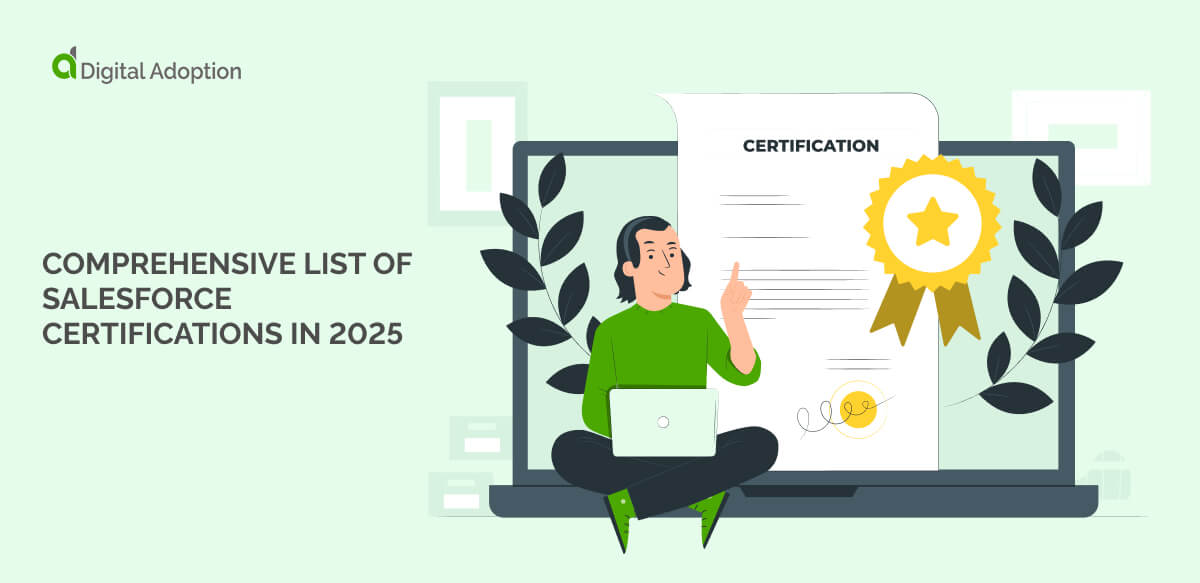Going digital doesn’t happen easily. All those puzzling office apps might eventually make your business run more efficiently, but it takes time and effort to make it happen.
That’s why so many companies choose to use digital adoption platforms. Today’s CIOs want to minimize the risks of experimentation and achieve value from their technology. And the best digital adoption platforms radically transform digital transformation efforts: educating users, generating product analytics, and making the most out of expensive software investments.
This article will explain how a DAP can make a difference to your organization through several digital adoption platform use cases. Here’s how we’ll do it:
- We’ll start with a short reminder of what a Digital Adoption Platform is.
- Then a trawl through some of the important highlights and benefits of a DAP
- Then, we will look at the industry-based digital adoption platforms’ use cases that show us what can be done,
- And finally, we’ll explore the enterprise software packages that work well with DAPS.
In short, this article will introduce the specific things you can do with a digital adoption platform to create positive business results. It won’t go deep into the general business benefits. But on the other hand, we won’t go as far as explaining step-by-step instructions for implementing a DAP.
These key use cases, drawn from WalkMe’s customer stories, can inspire you to consider how a DAP could be used in your organization.
How digital adoption platforms make a difference
Just imagine a large organization without a strategy for training users on their software for a moment. Some software will be under-used. Other software is misused or used inconsistently across different sites. And where staff must use an advanced digital transformation solution, they might take much longer than a previous manual solution!
These problems happen easily. But a digital adoption platform can tackle them at the source. Doing so leads to individual and collective benefits: including – better efficiency, resource management, technological resilience, agility, customer engagement, and better innovation.
DAPs make a difference by improving adoption, making manuals obsolete, harmonizing processes across sites, and offering data analytics.
Some of the specific tasks a DAP might achieve are:
- Employee training and onboarding
- Software adoption facilitation
- Change management support
- Self-service support
- Performance support
- Compliance and process adherence
- Analytics and insights
- Multilingual support
- Mobile learning and support
Where can we find use cases for all this DAP functionality? Let’s take a look.
The industries with exemplary digital adoption platform use cases
Digital Adoption Platforms can offer something to any industry. However, larger organizations are more likely to benefit from the DAP implementation. After all, DAPs are at their best in organizations with many business units, staff members, and multiple sites.
A long list of industries could include media, retail, insurance, hospitality, professional services, utilities, logistics, etc. But in this section, we’ll focus on three industries featured in the archives of WalkMe, one of the world’s leading DAP packages. The three industries are finance, healthcare, and technology.
Finance use cases
In the past few decades, digital transformation has been making a big impact on financial services. But companies are still finding ways to use digital technology to meet their challenges.
For example, BMO wanted to improve customer support without placing new demands on a hard-working support team. Customers have higher expectations than ever, so providing excellent answers to their digital questions was essential.
They used a DAP to support detailed in-app guidance for their users. Users didn’t have to struggle to find the resources they needed: the DAP meant that the answers were right there. And helpfully for business leaders, the DAP provided convenient data analytics on customers’ use of the system. This transparency means that the value of investments is totally clear.
The results were great – including a 50% drop in customer support requests and a reduction in development costs. This use case shows how DAPs make a big difference in customer satisfaction, even in high-pressure situations. The lessons could apply to any company with their eyes on improved customer success.
Healthcare use cases
Healthcare is another industry that’s seen a root-and-branch digital transformation. Patch manual records are a thing of the past – while patients can take advantage of many self-service facilities.
That’s great. But in a company like Christus Health, with over 45,000 international associates, there’s a high risk of confusion, digital friction, and redundant technology.
They implemented a DAP across an ecosystem of 20 applications. The platform helped teach healthcare professionals to learn applications “on the job” – improving their knowledge without making difficult training demands. The DAP resulted in dramatically enhanced understanding, with much fewer support calls.
In healthcare, mistakes can be a matter of life and death. But a DAP can provide bespoke training solutions that help users to be “right” when it matters.
Tech use cases
Finally, big tech companies aren’t immune from internal digital challenges. That’s what LinkedIn found when they tried to implement a new HRM system.
They implemented a DAP to focus on the key operations users could struggle with – provide custom-made training walkthroughs wherever necessary.
The DAP meant they reduced live training, increased productivity, and (most importantly) reduced employee frustration. It’s a valuable lesson in how a DAP can be applied to one specific software package within a company – which leads us to our next section.
Software with digital adoption platform use cases
You can apply a DAP to almost any software package – financial software, customer support, marketing, communication tools, and project management. But we’re going to have a sharp focus on three important areas: CRM, ERP, and HCM. These are some of the most wide-ranging and complex software packages around. Let’s look at what digital adoption platforms can do for them.
CRM automation
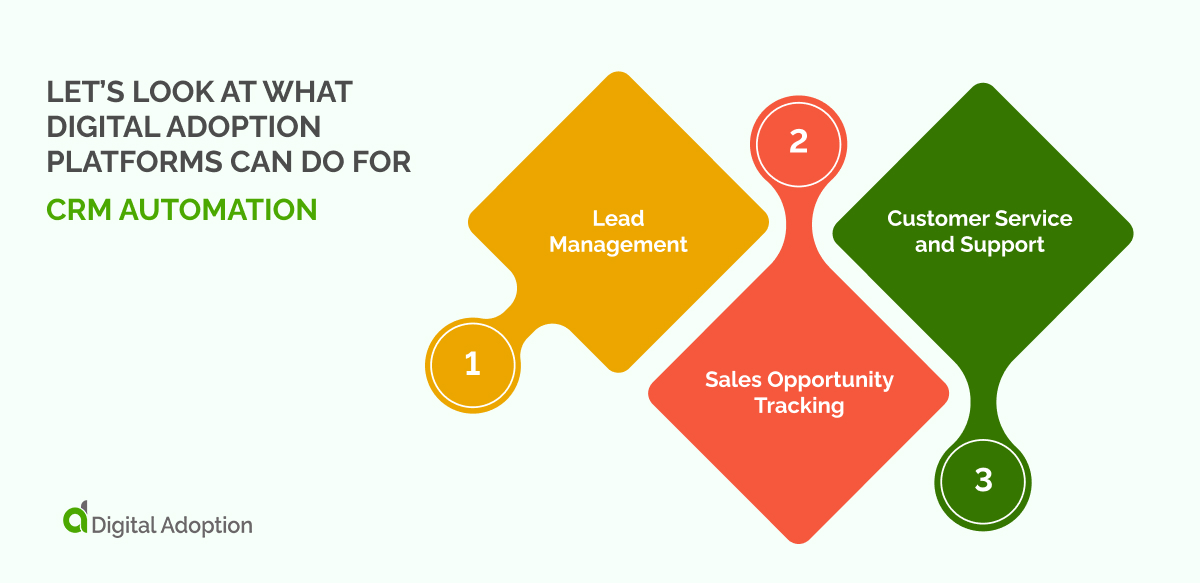
Customer Relationship Management packages like Hubspot and Zoho can make a major difference in every aspect of client-facing work. But complete CRM adoption can be difficult. Some areas where they can help include lead management, sales opportunity tracking, and customer service.
- Lead Management. A DAP can assist users in effectively managing leads within the CRM package. It can guide capturing and entering lead information, assigning ownership, and progressing leads through the sales pipeline.
- Sales Opportunity Tracking. Within a CRM system, tracking sales opportunities and managing the sales pipeline are crucial. A DAP can offer interactive support to sales representatives by guiding them through the stages of opportunity tracking, providing insights on updating opportunity status, recording activities, and managing associated tasks. The DAP helps sales teams monitor and advance opportunities effectively, increasing the likelihood of successfully closing deals.
- Customer Service and Support. CRM packages often include customer service and support functionalities. A DAP can enhance these processes by providing in-app guidance on managing customer inquiries, resolving tickets, and tracking customer interactions.
DAP use cases for ERP software
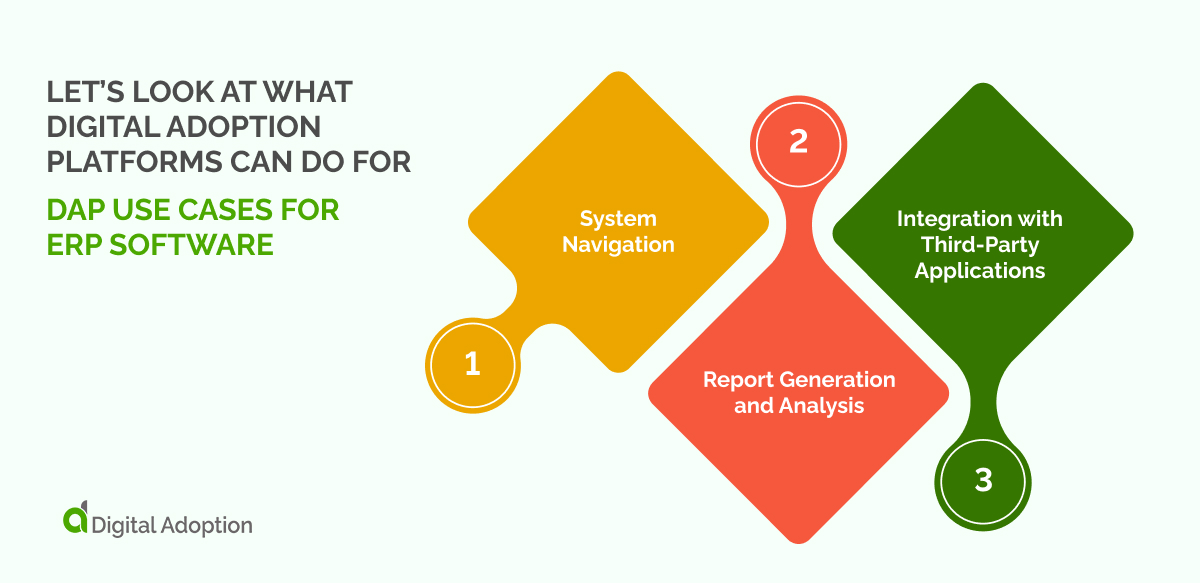
Enterprise Resource Planning (ERP) software can give leaders a 360-degree view of business activity. ERPs are a vital part of today’s enterprise technology ecosystems. Some of the top areas that a digital adoption tool can lead new users to success include the following:
- System Navigation. ERP systems can be complex and have numerous modules and functionalities. A DAP can assist users in navigating through the ERP package by providing in-app guidance, tooltips, and interactive tutorials.
- Report Generation and Analysis. ERP systems generate various reports to provide insights into business operations. A DAP can guide users in developing information, selecting appropriate parameters, and interpreting the results. It can offer step-by-step instructions, highlight important data points, and provide contextual explanations, enabling users to leverage the full potential of the reporting capabilities.
- Integration with Third-Party Applications. ERP systems often integrate with external applications or platforms. A DAP can guide the integration of the ERP package with third-party software, APIs, or data sources. It
HCM support
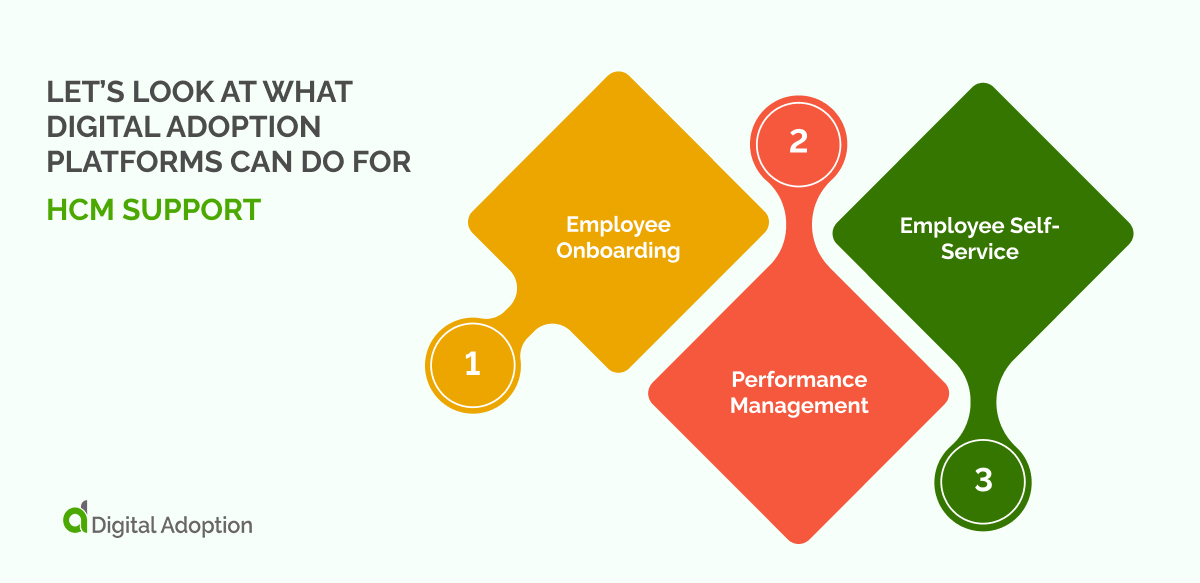
As the example of LinkedIn shows, HR packages are useful – but only when user adoption is sufficient. Digital adoption tools can help with the following areas:
- Employee Onboarding: A DAP can enhance onboarding by providing interactive tutorials, walkthroughs, and contextual guidance within the HCM software.
- Performance Management: The platform can offer in-app prompts, reminders, and suggestions to ensure consistent and effective performance management practices across the organization.
- Employee Self-Service: It can guide users through self-service functionalities like updating personal information, accessing pay stubs, requesting benefits changes, and managing leave requests. The DAP ensures users know available features, simplifies complex processes, and encourages self-reliance, reducing the burden on HR teams.
Conclusion: Make Digital Adoption Platforms work for you
Digital adoption platforms are a key tool for digital transformation success.
DAPs are not the only digital adoption solution, but they are one of the most stable and accessible methods of making your technology run better.
Achieving great results in digital transformation projects needs serious change management expertise. And a DAP fits into the so-called “human” side of digital transformation, providing help with training and effective monitoring, which are key factors for a positive DX outcome.
This article shows how DAPS supports specific examples of technology adoption across industries, software packages, and processes. The examples of finance, healthcare, technology, ERPs, CRMs, and HRMs, collectively illustrate the potential for DAPs in big organizations. User behavior is unpredictable: digital adoption software makes it a little easier.

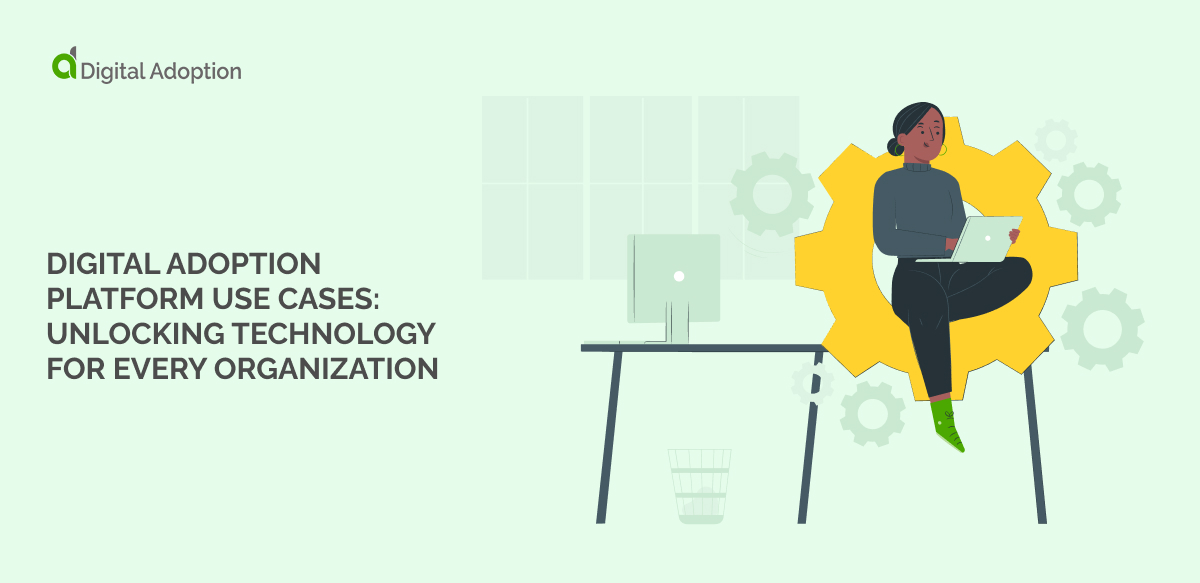






![18 Examples of AI in Finance [2025]](https://www.digital-adoption.com/wp-content/uploads/2025/06/18-Examples-of-AI-in-Finance-2025-300x146.jpg)
![14 Examples of AI in Manufacturing [2025]](https://www.digital-adoption.com/wp-content/uploads/2025/06/14-Examples-of-AI-in-Manufacturing-2025-300x146.jpg)




